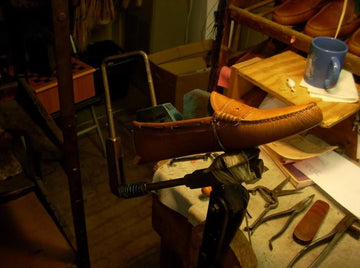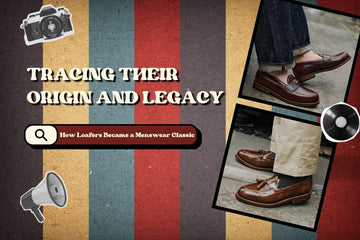Moccasins is a primitive and ancient technique. North American Indians initially used needles and threads to simply wrap animal skins (mostly buckskin) around their feet and sew them into shoes on the uppers. At the same time, animal skins were used to make soft soles for protection when going out hunting the victim's feet. The simple use of hand sewing can ensure the flexibility of basic outdoor walking.

This Ojibwa type, two-piece moccasin fts like a shoe and is splendid for still hunting and hiking, for camp use, for canoeing and yachting to wear as a house slipper.Materials: 1 pc.heavy oil-tan leather 12 by 22 in..3 yd.k-in.lacing,and 1 pair 3/16 in. thongs forties. Any dealer in leather can supply regular moccasin stock and laces.

Lay off the toe and bottom patterng on card board cut to shape,and punch out the holes. To obtain aright and a left for each piece, merely turn the templates over. Cut the leather with a sharp knife, press-ing hard enough to cut clear through the first time.Punch the lace holes with a leather punch, or if you want tight seams,use a ten penny nail.
These holes must be opened up with an ice pick when you lace, but as the moccasin dries, the leather shrinks tightly about the laces and makes the shoe water-tight. Note that the lace holes in the bottom of the moccasin are spaced almost twice as far apart as the holes in the toe. you must pucker or *full" the bottom piece between each stitch by pulling on the lace until each pair of holes are drawn opposite and even.Bevel or skive of the edge of each bottom around the toe on the wrong side or inside.

The smooth side of the leather is the right side and the outside. Soak the bottoms in water until thoroughly softened, but do not soak the toe pieces.Count of holes on either side and begin to lace through the center hole of each piece. Draw the-in. lace halfway through and lace down one side of the moccasin with one end.
Pull each stitch very tight, butting the edges of the leather together. Do not let them lap; the seam should be fat. Keep the lace fat and untwisted. Pull very hard until each pair of holes are opposite. Lace through the last pair of holes twice and push end of lace under the last two stitches.
Until the 18th century, following the banner of the Industrial Revolution, moccasin shoes moved from the primitive tribes of North American Indians to modern society. The press punching needle sewing machine invented by Mark Brownler has replaced the ancient hand sewing method, which has repeatedly improved the production efficiency of moccasin shoes. Coupled with the increasingly mature shoe making technology, moccasin shoes have become a kind of light and free shoes for city walking.
As a player who advocates primitiveness, the machine invention that puts efficiency first is certainly progressing, but Waner is determined to adopt the most primitive hand-sewing method, add more thinking in line with modern walking, and restore a pair of the most primitive moccasins.
As the soul of a pair of moccasins, hand-stitched stitches naturally have unique features. The birth of a pair of moccasin shoes is due to three steps:
handmade shoes
The success or failure of a pair of shoes lies in this step. When nailing the cut leather material to the last, the craftsman is required to shape the upper with different strengths according to the different conditions of the leather material, and at the same time fine-tune the entire pair of shoes. Handmade shoes are more conducive to the shape of the shoes and easier to fit the shape of the foot.

Hand sewing inner thread
The upper, mid-sole, welt and out sole are sewed together with one stitch, which is far more solid and durable than glue to ensure the superior walking characteristics of each pair of moccasins. At the same time, we chose the Vbram rubber out-sole to replace the original animal leather out sole, which effectively cushions and protects the soles of the feet and is more in line with modern walking.
hand sewing outer thread

As the identity proof of a pair of moccasins, the outer surface of the toe is stitched with double needle stitching to leave tight and meticulous stitches, which is also a proof of the strength and stability of the moccasin method.
The ancient craftsmanship is the most test of the craftsman's own experience.
The distance between the stitches, the selection of wire materials, and the grasp of sewing strength all require different considerations and treatments.





